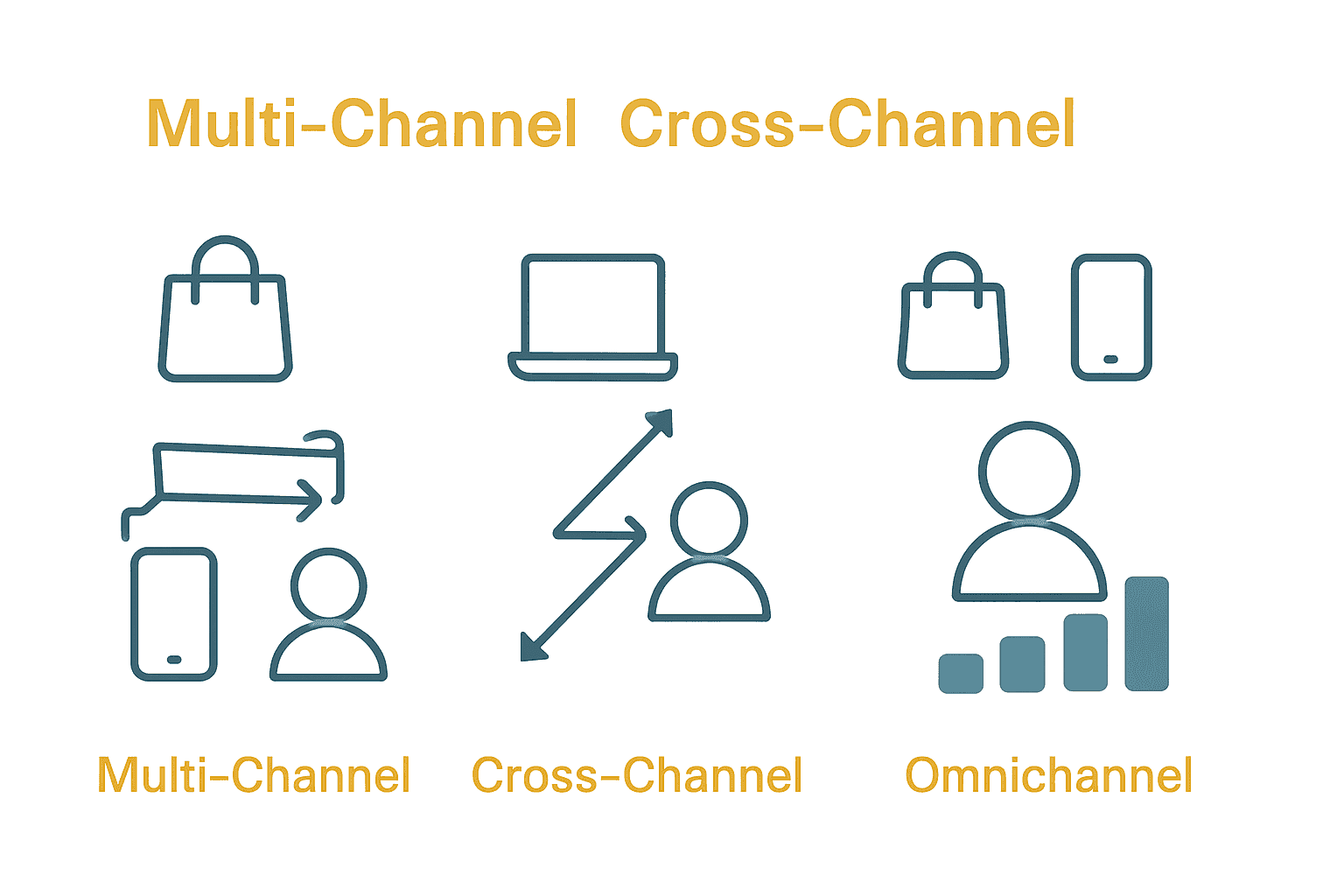Complete Guide to Multi-Channel Marketing
- Eddie The Chef

- 6 days ago
- 7 min read

Businesses that use multiple marketing channels can see engagement rates increase by as much as 250 percent, making multi-channel strategies a vital part of reaching today’s customers. Modern shoppers expect brands to connect with them through social media, email, websites, mobile apps, and even in-store experiences. Understanding how to build and manage these strategies helps you stay ahead, avoid wasted effort, and build lasting relationships across every customer touchpoint.
Table of Contents
Key Takeaways
Point | Details |
Integrated Approach | A cohesive multi-channel strategy ensures consistent branding across all platforms, enhancing customer experience. |
Data-Driven Insights | Effective multi-channel marketing relies on robust data collection and analysis to optimize resource allocation and measure performance. |
Adaptability | Businesses must remain flexible to shift marketing tactics in response to changing consumer behavior and preferences. |
Strategic Planning | Successful implementation of multi-channel marketing requires careful consideration of target audiences and technological capabilities. |
Defining Multi-Channel Marketing Strategies
Multi-channel marketing represents a strategic approach where businesses intentionally engage customers across multiple communication platforms and touchpoints. Unlike traditional single-channel strategies, this method recognizes that modern consumers interact with brands through diverse channels like social media, email, websites, mobile apps, and physical stores. As research from Deakin University highlights, implementing these strategies involves complex challenges such as understanding return on channel investment and tracking individual channel impacts.
The core philosophy of multi-channel marketing is creating a seamless, integrated experience that meets customers where they prefer to engage. This means developing a unified brand message that remains consistent across different platforms while adapting the communication style to suit each channel’s unique characteristics.
According to Griffith University, successful strategies must carefully manage potential issues like channel conflict and demand cannibalization.
Key components of an effective multi-channel marketing strategy include:
Comprehensive customer data collection and analysis
Consistent brand messaging across all platforms
Personalized communication tailored to specific channel audiences
Integrated tracking and performance measurement systems
Flexible communication approaches that adapt to changing consumer behaviors
By strategically leveraging multiple channels, businesses can create more opportunities for customer engagement, enhance brand visibility, and ultimately drive more conversational and conversion-oriented interactions. Digital Marketing Channels Guide provides additional insights into developing a robust multi-channel approach that resonates with your target audience.
Comparing Key Multi-Channel Approaches
Multi-channel marketing approaches vary significantly, each offering unique strategies for engaging customers across different platforms. As University of Technology Sydney research highlights, designing effective worldwide marketing channels requires a nuanced understanding of relationship management and distribution strategies. These approaches can be categorized into several primary models that businesses can leverage depending on their specific goals and target audience.
The first key approach is the integrated multi-channel strategy, where businesses create a cohesive experience across all channels. This method ensures that whether a customer interacts via social media, website, physical store, or mobile app, they receive a consistent brand message and seamless experience. According to CAUL OER Collective, optimizing channel objectives is crucial for achieving growth and market share.
Different multi-channel marketing approaches include:
Omnichannel Approach: Complete integration with fluid customer movement between channels
Multichannel Parallel Strategy: Simultaneous use of multiple channels with independent messaging
Cross-Channel Marketing: Coordinated messaging that allows customer interactions across connected platforms
Hybrid Approach: Combining digital and traditional marketing channels with strategic overlap
Successful implementation requires businesses to carefully analyze their target audience, technological capabilities, and resource allocation. Digital Marketing Channels Guide can provide additional insights into selecting the most appropriate approach for your specific business needs. The ultimate goal is creating a flexible, responsive marketing ecosystem that meets customers exactly where they prefer to engage.

How Multi-Channel Marketing Works
Multi-channel marketing operates through a complex ecosystem of interconnected communication platforms designed to engage customers across multiple touchpoints. Deakin University research highlights the intricate challenges of implementing these strategies, particularly in understanding return on channel investment and tracking individual channel performance. The fundamental principle is creating a synchronized marketing approach that allows customers to interact with a brand through their preferred channels seamlessly.
The operational mechanics involve collecting and integrating customer data across different platforms, enabling businesses to create personalized, targeted experiences. As Griffith University explains, managing multiple marketing channels requires careful navigation of potential issues like channel conflict and demand cannibalization. This means developing strategies that complement rather than compete with each other, ensuring a cohesive brand message.
Key operational components of multi-channel marketing include:
Data integration across all marketing platforms
Real-time customer interaction tracking
Adaptive communication strategies
Personalized content delivery
Cross-channel performance measurement

Successful implementation requires sophisticated technological infrastructure and a deep understanding of customer behavior. When executed effectively, multi-channel marketing creates a fluid, responsive ecosystem that meets customers exactly where they are. Multimedia Marketing Guide offers additional insights into creating compelling, integrated marketing experiences that resonate across different platforms and audience segments.
Benefits for Regional Australian Businesses
Multi-channel marketing offers transformative opportunities for regional Australian businesses to expand their reach and compete more effectively in increasingly complex market landscapes. Greater Dandenong highlights how strategic marketing approaches can support business growth by providing critical knowledge in areas like business planning, strategy, and innovation. For regional businesses, this means developing targeted marketing strategies that leverage multiple communication platforms to connect with local and broader audiences.
The primary benefits of multi-channel marketing for regional businesses include enhanced customer engagement, improved brand visibility, and more efficient resource allocation. By diversifying communication channels, businesses can reach customers through their preferred platforms, whether that’s social media, local print media, community events, or digital platforms. This approach allows smaller regional businesses to create sophisticated marketing experiences that were previously available only to larger metropolitan companies.
Key advantages for regional Australian businesses include:
Increased local and regional market penetration
More cost-effective marketing spend
Enhanced customer data collection and insights
Improved customer relationship management
Greater flexibility in marketing approach
Ability to compete with larger metropolitan businesses
Successful implementation requires understanding local market dynamics and customer preferences. Marketing Australia: Complete Guide for Regional Businesses provides additional insights into developing marketing strategies that resonate with regional Australian audiences. By embracing multi-channel marketing, regional businesses can transform their marketing approach from traditional methods to dynamic, responsive strategies that drive growth and customer connection.
Common Challenges and How to Avoid Them
Multi-channel marketing presents numerous complex challenges that can derail even the most carefully planned strategies. Deakin University research highlights significant measurement difficulties, particularly in understanding return on channel investment and accurately tracking individual channel performance. These challenges require businesses to develop sophisticated measurement approaches that can effectively evaluate the contribution of each marketing channel.
According to Griffith University, managing multiple marketing channels involves navigating complex issues like channel conflict and potential demand cannibalization. This means businesses must carefully design strategies that complement rather than compete with each other, ensuring a cohesive and integrated marketing approach that maximizes overall effectiveness while minimizing internal friction.
Key challenges and their strategic solutions include:
Data Integration Complexity
Challenge: Inconsistent data across different channels
Solution: Implement unified customer data platforms
Channel Performance Measurement
Challenge: Difficulty tracking individual channel contributions
Solution: Develop advanced attribution modeling techniques
Message Consistency
Challenge: Maintaining uniform brand messaging
Solution: Create comprehensive brand communication guidelines
Resource Allocation
Challenge: Inefficient distribution of marketing resources
Solution: Use data-driven insights for strategic channel investment
Successful multi-channel marketing requires continuous learning and adaptation. 7 Examples of Regional Branding Strategies offers additional insights into developing robust marketing approaches that can overcome these common challenges and create more effective, integrated marketing strategies.
Unlock Growth with Expert Multi-Channel Marketing Support
Struggling to create a seamless, engaging multi-channel marketing strategy that truly connects with your customers? You are not alone. The complexities of managing consistent messaging across social media, email, websites, and physical locations can feel overwhelming. Challenges such as tracking performance, avoiding channel conflict, and delivering personalised content often hold regional businesses back from reaching their full potential.
At Marketing Recipes Australia, we understand these pain points deeply. With over 30 years of experience tailored specifically to regional Australian businesses, we combine traditional video production and cutting-edge digital marketing tools to craft integrated campaigns that resonate. From video marketing to social media management and personalised content creation, our full-spectrum solutions help you leverage every platform with consistent messaging and measurable results.

Ready to stop juggling disconnected channels and start driving real growth? Discover how our comprehensive services can transform your marketing into a harmonised, customer-focused powerhouse. Visit Marketing Recipes Australia today and let us help you build a multi-channel marketing ecosystem that works tirelessly for your business.
Frequently Asked Questions
What is multi-channel marketing?
Multi-channel marketing is a strategic approach where businesses engage customers through multiple communication platforms such as social media, email, websites, mobile apps, and physical stores, creating a cohesive experience and unified brand message.
How can I effectively implement a multi-channel marketing strategy?
To implement a successful multi-channel marketing strategy, businesses should focus on comprehensive customer data collection, maintain consistent messaging across all channels, tailor communication to specific audiences, and integrate tracking systems to measure performance across platforms.
What are the main challenges of multi-channel marketing?
Common challenges include data integration complexity, measuring the performance of individual channels, maintaining message consistency across platforms, and efficiently allocating marketing resources to different channels.
What are the benefits of multi-channel marketing for businesses?
The benefits of multi-channel marketing include enhanced customer engagement, improved brand visibility, more efficient use of marketing resources, increased market penetration, and the ability to create sophisticated marketing experiences that cater to customer preferences.
Recommended
Comments